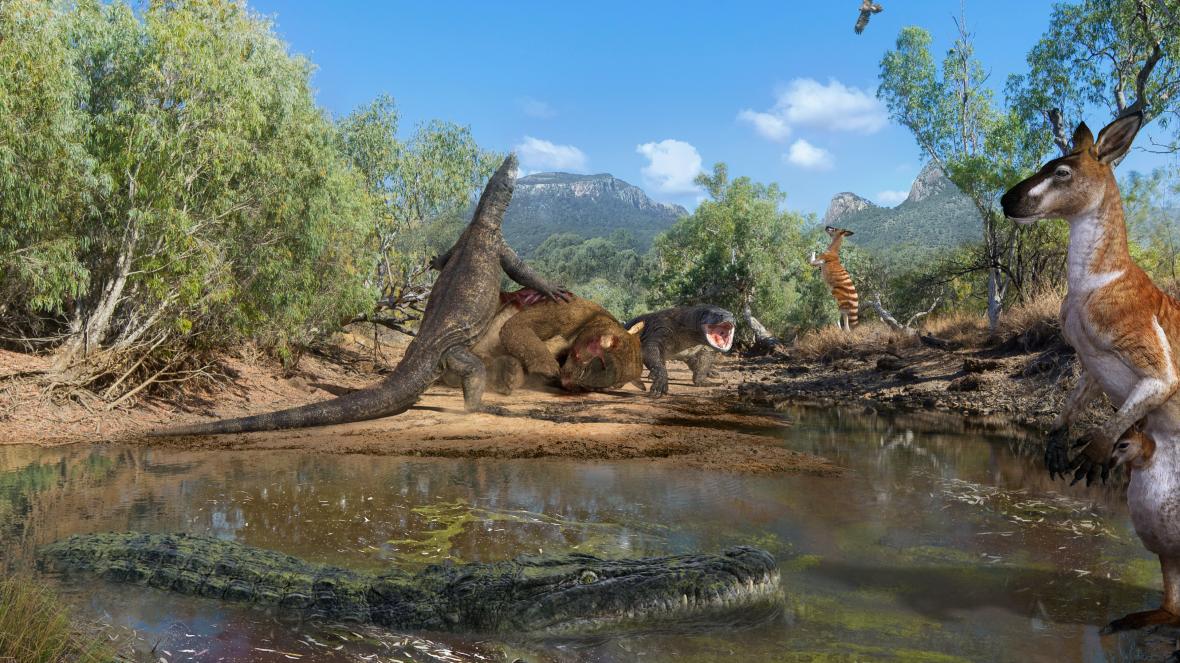Ancient History
Scientists: Ancient Australians Lived With Huge Kangaroos, Lizards, Other Megafauna for 20,000 Years
The enormous megafauna roamed Australia until about 40,000 and years ago, according to paleontologists at the Queensland Museum.

(TMU) – Massive kangaroos who roamed prehistoric Australia have been uncovered at an ancient fossil site in central Queensland.
The gigantic kangaroos, which towered at a height of over 8 ft (2.5 meters) and weighed upwards of 600 pounds (274 kg) were dug up at a paleontological site alongside the remains of over a dozen other oversized creatures, including car-sized lizards, huge wombats, crocodiles as long as buses, and a huge marsupial “lion” called the Thylaceo.
The enormous megafauna roamed Australia until about 40,000 and years ago, according to paleontologists at the Queensland Museum.

It was previously thought that Australia’s megafauna were driven to extinction by human over-hunting and were all gone shortly after man arrived/QUEENSLAND MUSEUM
While it was once believed that the species were hunted by humans to extinction, researchers have determined that the huge creatures lived alongside Indigenous Australians for up to 20,000 years. Major changes to the environment such as climate change were the likely cause of the tropical giants being wiped out.
Dear god, this thing was huge.
Pleistocene Macropus sp. (giganteus/titan) takes the title from Procoptodon goliah for largest kangaroo.
paper (discusses some really cool stuff about Ice Age extinctions and how climate played a role): https://t.co/PODz01laG7 https://t.co/fVwU4Yb2u9 pic.twitter.com/G9wN1zXxOC
— Aditya Srinath (@adi_fatalis) May 18, 2020
Dr. Scott Hocknull, a paleontologist who led the research project, told Australian news program Sunrise:
“It’s an amazing discovery – these animals were absolutely enormous.
“And the animals that ate these were even bigger. We had gigantic reptiles living at the same time as people.”
Imagine a kangaroo as tall as a bus! Giant roos are one of 13 extinct species discovered west of Mackay. How they lived and why they died is at the centre of a Queensland dig, published today in a prestigious international paper. https://t.co/VZ3A1cpmr5 @ErinEdwards7 #7NEWS pic.twitter.com/uQdF0QZXF3
— 7NEWS Brisbane (@7NewsBrisbane) May 18, 2020
However, extreme climate change drove the ancient creatures to extinction – a conclusion Hocknull reached after finding evidence of raging fires, degrading habitats, and major droughts that coincided with the extinction of the megafauna.
Megafauna are animals that weighed around or over 100 pounds (44 kg) and bear a close resemblance to related species that continue to roam the Earth today. More common megafauna species include the saber-toothed tiger and North America’s woolly mammoth. Nearly all megafauna are now extinct.
Australia is currently home to unusual endemic creatures such as the duck-billed, egg-laying platypus as well as potoroos, bandicoots, echidnas, wallabies, koalas and kangaroos.
During the prehistoric period, Australia was also the host to a range of unique megafauna such as gigantic marsupials (mammals with a pouch) including the sloth bear-like Palorchestes, super-large monitor lizards like the Megalania goanna, and rhinoceros-sized wombat-like marsupials such as the Diprotodon.
Australia also had gigantic, armored tortoises with clubbed tails, huge flightless birds, land-dwelling crocodiles, and giant constricting snakes.
Check out our new #3D collection of tropical #megafauna from North #QLD on #Sketchfab. See these giant creatures, interact with their #fossils & learn how we as #palaeontologists interpret their bones. Also check out our #dinosaurs #qldmuseum #MuseumAtHome https://t.co/rQFrPyHbfb
— Róchelle Lawrence (@PalaeoShell) May 19, 2020
Since 2008, the Queensland research team has yielded spectacular finds, including bones that once belonged to reptilian mega-predators and lizards or goannas that measured 22 feet. In total, at least 16 megafauna species have been discovered at the site.
Speaking to Daily Mail Australia, Hocknull explained:
“This is really exciting as it’s the first time we’ve been able to provide a picture of what tropical north looked like … The megafauna at South Walker Creek were uniquely tropical, dominated by huge reptilian carnivores and mega-herbivores that become extinct about 40,000 years ago – at least 20,000 years after humans arrived in Australia.
“The first people of Australia most likely saw these animals.”
The researcher added that it remains unclear to what extent humans had contact with them, especially since dangerous mammalian creatures like the pouched “lion” Thylacoleo stalked the territory seeking out prey.
It has been a 12 year project with more exciting things to come! @qldmuseum https://t.co/jfzJLufsYY
— Scott Hocknull (@Aussiedinosaurs) May 18, 2020
The creatures’ extinction was a likely result not so much of human intervention – but of changing climate conditions. Hocknull continued:
“We find that their extinction is coincident with major climatic and environmental deterioration both locally and regionally, including increased bushfires, reduction in grasslands and loss of freshwater.”
“Together, these sustained changes were simply too much for the largest of Australia’s animals to cope with.”
With Australian society and wildlife still reeling from the massive bushfires that raged across the country earlier this year, Hocknull sees the research as offering important insights to how we view the impact of climate, fire, vegetation change, and water availability today. Hocknull said:
“Not since the time of the dinosaurs has Australia been home to such magnificent giants, and yet within a geological instant they were gone forever. There is a message in that for everyone.”
Typos, corrections and/or news tips? Email us at Contact@TheMindUnleashed.com
